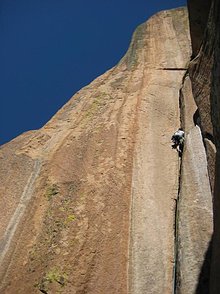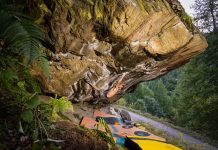 He knew about the crack because he had previously climbed this route, Zoo View, on Moores Wall in North Carolina. In fact, he had not had any difficulty climbing it, but he was having difficulty now.The climbing to this point didnít quite seem the same as he remembered. Last time he recalled stepping down and traversing left, but now the holds were unfamiliar. Craig could feel his strength waning, but since he was absolutely sure the crack would be above the bulge, he committed.
He knew about the crack because he had previously climbed this route, Zoo View, on Moores Wall in North Carolina. In fact, he had not had any difficulty climbing it, but he was having difficulty now.The climbing to this point didnít quite seem the same as he remembered. Last time he recalled stepping down and traversing left, but now the holds were unfamiliar. Craig could feel his strength waning, but since he was absolutely sure the crack would be above the bulge, he committed.
He climbed deliberately on the small holds over the bulge, but the crack wasnít there; it was ten feet to his right. He had traversed too far left. He was on a precarious perch running out of strength, when his hand slipped and he fell. Craig fell and swung into an arÍte hitting his pelvis, back, and head. Fortunately he was wearing a helmet and didnít break anything, escaping the incident only badly bruised.
It would seem as if Craig was being mentally tough by staying focused on the goal and not letting fear or the pump distract him; yet, that mental toughness resulted in a terrible fall and barely escaping a serious injury. When we think of being mentally tough we envision someone whose mind has power over oneís body. Itís a mind over matter approach. We envision the climber staying committed to the goal without giving in to the desire to quit.
This mind-over-matter approach caused Craigís mind to perceive the situation as he wished it to be, not as it actually was. With a mind-over-matter approach you rely on what your mind knows from past experience. This can be helpful to a degree in doing risk assessment, but it can interfere with perceiving the situation as it is now. This is what happened to Craig. He had climbed Zoo View before. He engaged Zoo View the second time with mental perceptions that he was ìabsolutely sure where the route wentî and that ìit wouldnít be difficult. Both of these perceptions were wrong. He was getting feedback from the situation (the route and his body) telling him that he was off route and too pumped for committing to a no-fall section. His mind, however, still attached to the old perceptions, ignored this feedback and tried to distort the situation to fit its perceptions. He then engaged an inappropriate risk and fell.
Mental flexibility, conversely, allows you to stay receptive to the feedback you get from a situation. The fact that a situation is stressful indicates that learning needs to take place. Learning converts stress into comfort. In order to do this conversion you need to take in the stress, accept it, and process yourself through it. Doing this requires flexibility, not toughness. You donít distort the situation to fit your mindís perception of it, but rather let go of your mindís perception to see the situation as it is now. You do this in a matter-over-mind, not a mind-over-matter, approach.By engaging your body (matter) and keeping attention on the tasks your body is doing to climb, you allow your mind to accept and process the stress. What is required is to keep attention on the current task. Attention shouldnít be on thinking about the climbing. This will lead to reinforcing the existing mental construct and enhance toughness not flexibility. Attention should simply be immersed in what your body is doing to climb.



![[VIDEO] Irmgard Braun: Record Breaking Rock Climber Who Gets Stronger Every Year Irmgard Braun: Record Breaking Rock Climber Who Gets Stronger Every Year (c) Hannah Morris Bouldering](https://www.climbing.de/wp-content/uploads/2025/11/youtube_MpAJEENfEjg-218x150.jpg)

![[VIDEO] The Challenge – Steve McClure The Challenge - Steve McClure (c) Petzl Sport](https://www.climbing.de/wp-content/uploads/2025/11/youtube_mfK9ynVsDvI-218x150.jpg)
![[VIDEO] Silence 9c/5.15d – The journey begins for Will Bosi Silence 9c/5.15d - The journey begins for Will Bosi (c) William Bosi](https://www.climbing.de/wp-content/uploads/2025/11/youtube_ujb7YRfE-7k-218x150.jpg)
![[VIDEO] Yosemite Crack Testpiece: Connor Herson on Magic Line Yosemite Crack Testpiece: Connor Herson on Magic Line (c) Fusis Films](https://www.climbing.de/wp-content/uploads/2025/10/youtube_h4GEt5iSZpA-218x150.jpg)
![[VIDEO] Hardest Trad Flash Ever | Adam Ondra | Lexicon E11 Hardest Trad Flash Ever | Adam Ondra | Lexicon E11 (c) Mammut](https://www.climbing.de/wp-content/uploads/2025/06/youtube_SAUyrDLG5xM-218x150.jpg)









